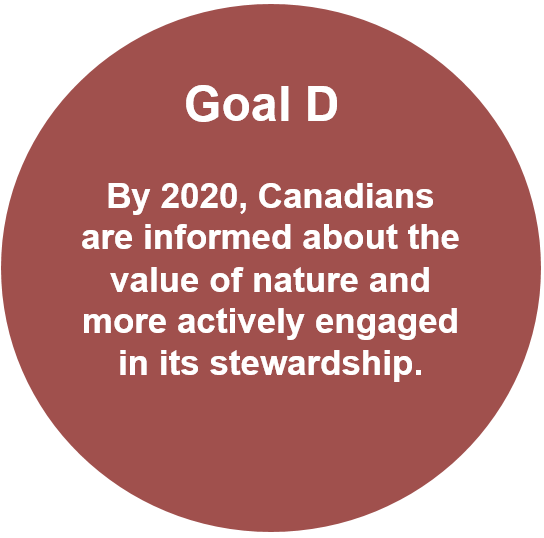Canada Target 19. By 2020, more Canadians get out into nature and participate in biodiversity conservation activities.
About the Target
Spending time in nature is a favourite pastime for many Canadians. This includes visiting parks and wilderness areas, participating in wildlife monitoring programs, and engaging in other nature-related activities. There are a range of benefits for people of all ages. Experiences in nature can improve physical and mental health and support children’s development. Nature-based tourism provides economic benefits for Canada.
Involvement in nature-based activities can increase personal connections with the natural world and encourage an understanding and appreciation of the importance and beauty of nature. It can also lead to Canadians becoming more involved in biodiversity conservation efforts working together with governments, Indigenous peoples, conservation organizations, industry, and youth towards achieving biodiversity goals.
Canada Target 19 is linked with the following global Aichi target under the United Nations Convention on Biological Diversity Strategic Plan for Biodiversity 2011-2020:
Aichi Target 1 - By 2020, at the latest, people are aware of the values of biodiversity and the steps they can take to conserve and use it sustainably.
Aichi Target 4 - By 2020, at the latest, Governments, business and stakeholders at all levels have taken steps to achieve or have implemented plans for sustainable production and consumption and have kept the impacts of use of natural resources well within safe ecological limits.
2020 Final Assessment
In 2019-2020, there were 16.1 million visits to national parks and marine conservation areas, an increase of 29% from visits in 2010-2011.[i] The Households and the Environment Survey found that, in 2019, 22% of Canadian households surveyed engaged in unpaid activities to conserve or protect either the environment or wildlife compared to 18% in 2017. In the same survey, 90% of Canadian households had a nearby park or public green space in 2019, up slightly from 87% in 2017. Of these households, 85% reported that they visited these parks and green spaces.[ii] Canadian participation in voluntary citizen-science monitoring programs has consistently increased over the decade. Since its launch in 2015, uptake of iNaturalist Canada has grown exponentially – by the end of 2020, over 60,000 participants had contributed over 4 million observations, with nearly half of the observations contributed in 2020.[iii] Birds Canada also experienced continuous growth in citizen science activity through the end of the decade with increases of up to 25% per year in some programs such as eBird Canada.[iv]
This target has been met given that almost all the indicators show very positive trends. The public is engaged in conservation and is embracing spending time outdoors in passive or active pursuits. Increased public interest in the benefits of spending time in nature has resulted in the development or implementation of strategies and tactics to manage peak visitation to ensure the protection of natural environments and quality experiences in parks and protected areas. For example, shuttle services have been implemented in Lake Louise (Banff National Park) and reservable parking has been introduced in Bruce Peninsula National Park to manage visitor volumes. Increasing the number of parks and protected areas in Canada will be beneficial for Canadians on many fronts, but there will remain a continued need for efforts and innovations in conservation education, demand management, and low-impact behaviours.
[i] Environment and Climate Change Canada (2021) Progress Report on the 2019-2022 Federal Sustainable Development Strategy
[ii] Statistics Canada (2021) Households and the Environment Survey.
[iii] iNaturalist Canada (2020) Journal archives for December 2020.
[iv] Birds Canada (2021) Birds Canada Annual Report 2020-2021.
Contributing Actions
The Government of Canada maintains a Citizen Science Portal with over 30 of the 44 programs listed devoted to biodiversity related issues.
Ontario Parks supports Healthy Parks Healthy People; a worldwide movement that works to promote and understand the link between a healthy environment and a healthy society. The initiative promotes the role of parks to counteract the loss of natural areas and promote access to the health benefits of being in nature.
National, provincial, and territorial park agencies all carry out outreach, interpretive programs and visitor education. For example, Parks Canada’s Learn-to Camp activities and the Youth Ambassadors program are such initiatives.
In 2017, the Canadian Parks Council (CPC), a collaborative forum for Canada’s national, provincial and territorial park agencies, partnered with the Canadian Parks and Recreation Association (CPRA) to develop Parks for All, an action plan for Canada's parks community to facilitate connections that support healthy Nature and people.
The CPC funds the Canadian Parks Collective for Innovation and Leadership (CPCIL) which is a collaborative of parks and protected areas agencies, academic institutions, Indigenous conservation leaders and others. The CPCIL was established in 2018 to carry out research, training, mentorship, foster communities of practice, and connect research and practice.
NatureWatch is a citizen science portal including a set environmental monitoring programs that encourage people to learn about the environment while gathering information that can be used by scientists. The programs are designed to promote scientific observation and data collection skills. Information submitted by participants is pooled and used by researchers at several Canadian universities to improve scientific knowledge of changes in Canada’s biodiversity, climate, and the natural environment.
Participants can use the NatureWatch website on a smartphone to record frogs, flowers, worms, ice conditions and other natural phenomena. Programs under the NatureWatch name include:

